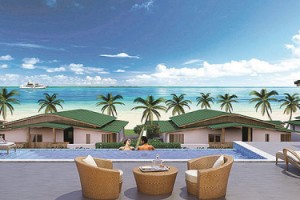When the Duterte administration took over three years ago, the Philippine tourism industry was enraptured to discover that golf tourism would be a priority project of the administration. This was tremendous news and promised so much for golf in the country and for the economy at large.
Here are some facts about the golf tourism industry:
The value of golf tourism is estimated at a whopping $200-billion industry worldwide. Asia has seen a 23-percent increase in golf participation in the Asia Pacific since 2002. Current estimates peg the number of golf fans in Asia to approximately 242 million people of which 26 percent are millennials.
Golfers are high-value tourists. They spend significantly more than the average tourist. How much more? Try 120 percent more than your average tourist. Think about it. If the average tourist spends $1,000 on a four-day, three-night stay in the country, a golfer on holiday will spend $2,200. That’s more money that goes directly into the local economy, benefiting people in the hospitality, leisure and golf industries.
Asia is the fastest-growing region in the world for golf tourism. China, Malaysia and Thailand have the lion’s share of tourism dollars spent. How much of this gold mine benefits the Philippines? Nothing significant. Zip. Nada. Honestly, we’re a paradox to our neighbors in the region.
Golf in our country is difficult, at best. Most times, it’s just frustrating for the unseasoned traveler. Even large tour operators have thrown their hands up in surrender at the rigors of doing business here. We are being passed over.
Without an industry-wide covenant that allows all the entities in local golf to pursue the tourist dollar, dealing with each golf club presents its own unique challenges. The lack of consistency and any kind of national policy encouraging golf tourism makes golfing in the country a logistical quagmire.
It doesn’t take a genius to figure out that the Philippines is the big loser here. Golf tourism is perhaps the easiest path by which the Department of Tourism can increase the economic impact of tourism spending in the country. No additional infrastructure is required. Everything needed is already in place. Sure, things could work better, but we have enough in place to make golf tourism work.
There is plenty of interest. During the Asian Golf Tourism Convention last year, the number of delegates to this edition of the AGTC was up by 25 percent over last year’s meeting in Vietnam. AGTC 2018 attracted over 560 participants, including 200+ golf tour operators from 33 countries. A record number of golf tour operators (over 160) participated in golf familiarization tours before and after the convention, experiencing firsthand what the Philippines has to offer the international golf traveler.
So much potential and what has the industry wrought? Again, nothing. This is a tragedy.
Part of the blame must be leveled at the Department of Tourism (DOT). The change of leadership, unfortunately, also meant a change of direction for the DOT. The sports tourism projects were shelved in favor of farm tourism and the development of other tourism markets.
Given the nature of the exit of the former secretary, perhaps the current secretary is playing a little too close to the chest. It is beyond reasoning that a worthy project that can earn the country millions of dollars in tourist revenue while introducing the country to a new tourist demographic is shelved for no other reason than it was someone else’s idea.
This generation might have forgotten that golf in the Philippines is part of our heritage. Golf’s roots here run deep. Manila Golf Club is one of the oldest golf clubs in Asia. The Iloilo Golf and Country Club, known more popularly as Santa Barbara, was established in 1903 and is the oldest continuously existing golf course in the country and one of the oldest in the region.
Some of the best golf courses in Asia are right here in the country. True, they might not be able to compete with some courses in Malaysia, Singapore and Thailand in terms of conditioning and technology, but in pure golf terms (shot values, aesthetics, challenge to the golfer, resistance to scoring, etc.), our golf courses are as good or better than anything in Asia.
The Asian Golf Tourism Convention wasn’t the only opportunity to develop this billion-dollar industry in our country. The Asian Tour has held events in the Philippines, sporadically over the last two decades. The most recent series, the Resort World Manila Masters, was telecast live worldwide to an estimated 750 million people. The Manila Southwoods Golf and Country Club’s Masters Course looked magnificent on HD TV. You couldn’t pay for exposure golf in the Philippines got in the five weeks that the tournament was held over the five years it ran. The million dollars spent annually on the tournament yielded $35 million in exposure for the country worldwide.
The aborted match between Rory McIlroy and Dustin Johnson, then the top two golfers on the planet that was supposed to be held at Pradera Verde Golf and Country Club in Lubao, Pampanga, had it actually happened, would have put the country on the map and the world’s collective consciousness. Instead, its cancellation highlights the ineptness of how things are done here.
What is it going to take to move golf tourism forward in the Philippines?
It is sad that we are unable to work together effectively on such a worthwhile endeavor. The DOT must provide the leadership to bring the golf clubs together to create a uniform set of policies that all the clubs will agree to abide by in order to grow tourism in the country.
The establishment of professional golf tournaments that are televised worldwide are the most cost-effective method of showcasing Philippine golf courses to the world. For a week, live coverage is streamed to millions of households worldwide. It could provide the springboard for a yearlong marketing campaign to bring golfers to the country.
The Asian and European Tours have been actively trying to organize tour stops for both men’s and ladies’ tours in the Philippines. We’ve hosted the World Championships of basketball, why can’t we have a world-class golf tournament? It would certainly provide a greater financial impact over a longer term than a basketball tournament. A professional ladies’ tournament would certainly create a lot of local interest and serve as a springboard to host other professional events.
Former DOT Assistant Secretary Frederick Alegre begun the process by organizing the golf clubs and other members of the golf community into the Philippine Golf Tourism Council to begin the process and provide oversight for the development of the necessary infrastructure required to grow the industry. Sadly, the change of leadership at the department put the council in limbo. Yet, the members of the council remain ready, lest the climate change and the country decides to act positively on this issue.
There is also the need to professionalize the people that rely on golf for their livelihoods. There are Professional Golfers Association chapters in China, Malaysia and Thailand. These associations elevate the level of expertise of golf industry professionals, as well as their standard of work. They provide direct contact with golfers and are the game’s ambassadors. Good service and professionalism will bring return business.
We don’t have to go this alone. There are many entities (The Asian and European Tours, the PGA of Asia) that are more than willing to help. Their expertise can shorten the learning curve in many aspects and with positive action on our part, create real opportunities for golf tourism. An investment on our part is required but to kickstart an industry worth so much, wouldn’t it be worth it?
But all will be for naught if we cannot work together toward this common goal. What is it going to take to bring the industry together? Who is going to lead Philippine golf into the future?
The article "Why can't golf tourism take hold in the Philippines? Mirror" was originally published on https://businessmirror.com.ph/2019/07/06/why-cant-golf-tourism-take-hold-in-the-philippines/





